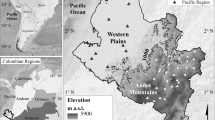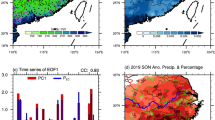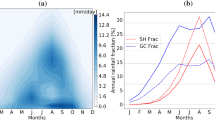Abstract
In this study, we investigate a long-term modulation in the relationship between Indian summer monsoon rainfall with the subsequent Australian summer monsoon rainfall. The two monsoon rainfall time series are significantly correlated at 0.3 at the 99 % confidence level. However, the relationship weakens during the 1932–1966 period, with the inter-monsoon correlation for the period falling below statistical significance. We find that this modulation is consistent with a breakdown of the typical El Niño-Southern Oscillation (ENSO) influence on sea surface temperature in the northern region of Australia, during this period. In addition, a change in the relative influences of ENSO and Indian Ocean Basin-wide Warming sea surface temperature anomalies on the Australian summer monsoon rainfall is also apparent across different time periods.






Similar content being viewed by others
Notes
The NINO3 index, and EMI (Ashok et al. 2007) are defined as the area-averaged SSTA over the box 90°W–150°W, 5°S–5°N, and 165°E–140°W, 10°S–10°N, respectively. The IODMI is defined as the gradient of SSTA between the two boxes 50°E–70°E, 10°S–10°N, and 90°E–110°E, 0°–10°S (Saji et al. 1999). The JJAS and DJF seasonal anomalies have obtained by averaging all the monthly anomalies of the respective season. The IOBW has been obtained, following Yang et al., by area-averaging the SSTA for the DJF season over [40°E–110° E, 20°S–20°N].
Those summers when the NINO3 index exceeds 1 standard deviation.
The statistical significance for the sub-periods I, II, and III at the 80 % confidence level from a 2-tailed t test are, respectively, 0.24, 0.21, and 0.25.
References
Ashok K, Guan Z, Yamagata T (2001) Impact of the Indian Ocean dipole on the relationship between the Indian monsoon rainfall and ENSO. Geophys Res Lett 28(23):4499–4502
Ashok K, Guan Z, Yamagata T (2003) A look at the relationship between the ENSO and the Indian Ocean dipole. J Meteo Soc Jpn 81:41–56
Ashok K, Chan Wing-Le, Motoi Tatsuo, Yamagata Toshio (2004) Decadal variability of the Indian Ocean dipole. Geophys Res Lett. doi:10.1029/2004GL021345
Ashok K, Behera SK, Rao SA, Weng H, Yamagata T (2007) El Niño Modoki and its possible teleconnection. J Geophys Res. doi:10.1029/2006JC003798
Ashok K, Sabin TP, Swapna P, Murtugudde RG (2012) Is a global warming signature emerging in the tropical Pacific? Geophys Res Lett. doi:10.1029/2011GL050232
Cai W, Cowan T (2009) La Niña Modoki impacts Australia autumn rainfall variability. Geophys Res Lett. doi:10.1029/2009GL037885
Cai W, Cowan T, Sullivan A (2009) Recent unprecedented skewness towards positive Indian Ocean dipole occurrences and their impact on Australian rainfall. Geophys Res Lett. doi:10.1029/2009GL037604
Chambers DP, Tapley BD, Stewart RH (1999) Anomalous warming in the Indian Ocean coincident with El Niño. J Geophys Res 104:3035–3047
Chang CP, Li Tim (2000) A theory for the tropical Tropospheric Biennial Oscillation. J Atmos Sci 57(14):2209–2224
Delworth TL, Mann ME (2000) Observed and simulated multidecadal variability in the Northern Hemisphere. Clim Dyn 16:661–676
Dong B, Sutton RT, Scaife AA (2006) Multidecadal modulation of El Nino–Southern Oscillation (ENSO) variance by Atlantic Ocean sea surface temperatures. Geophys Res Lett. doi:10.1029/2006GL025766
Fasullo J (2004) Biennial characteristics of all India rainfall. J Clim 17:2972–2982. doi:10.1175/1520-442(2004)017<2972:BCOIMR>2.0.CO;2
Fedorov AV, Philander SG (2000) Is El Niño changing? Science 288:1997–2002
Folland CK, Parker DE, Colman A, Washington R (1999) Large scale modes of ocean surface temperature since the late nineteenth century. Beyond El Nino: decadal and interdecadal climate variability. Springer, Berlin, pp 73–100
Gill AE (1980) Some simple solutions for heat-induced tropical circulations. Q J R Meteorol Soc 106:447–462
Goswami BN, Madhusoodanan MS, Neema CP, Sengupta D (2006) A physical mechanism for North Atlantic SST influence on the Indian summer monsoon. Geophys Res Lett. doi:10.1029/2005GL024803
Hendon HH (2003) Indonesian rainfall variability: impacts of ENSO and local air–sea interaction. J Clim 16:1775–1790
Hendon HH, Lim E-P, Liu G (2012) The role of air–sea interaction for prediction of Australian summer monsoon rainfall. J Clim 25:1278–1290
Jones DA, Wang W, Fawcett R (2009) High-quality spatial climate data-sets for Australia. Aust Meteorol Oceanogr J 58:233–248
Joseph PV, Liebmann B, Hendon HH (1991) Interannual variability of the Australian summer monsoon onset: possible influence of Indian summer monsoon and El Niño. J Clim 4:529–538
Kao HY, Yu JY (2009) Contrasting Eastern-Pacific and Central-Pacific types of ENSO. J Clim 22:615–632
Kerr RA (2000) A North Atlantic pacemaker for the centuries. Science 288:1984–1986
Knutson TR, Manabe S (1998) Model assessment of decadal variability and trends in the tropical Pacific Ocean. J Clim 11:2273–2296
Krishna Kumar K, Rajgopalan B, Cane MK (1999) On the weakening relationship between the Indian monsoon and ENSO. Science 284:2156–2159
Krishna Kumar K, Rajagopalan B, Hoerting M, Bates G, Cane M (2006) Unraveling the mystery of Indian monsoon failure during El-Nino (global publicity). Science 314:115–119
Krishnan R, Sugi M (2003) Pacific decadal oscillation and variability of the Indian summer monsoon rainfall. Clim Dyn 21:233–242
Kug J-S, Jin F-F, An S-Il (2009) Two types of El Niño Events: cold tongue El Niño and warm pool El Niño. J Clim 22:1499–1515
Lavery BM, Joung G, Nicholls N (1997) An extended high quality historical rainfall data set for Australia. Aust Meteorol Mag 46:27–38
Li Y, Jourdain NC, Taschetto AS, Ummenhofer CC, Ashok K, Gupta AS (2012) Evaluation of monsoon seasonality and the tropospheric biennial oscillation transitions in the CMIP models. Geophys Res Lett 39:L20713
Luo JJ, Masson S, Behera S, Gualdi S, Navarra A, Delecluse P, Yamagata T (2003) South Pacific origin of the decadal ENSO-like variation as simulated by a coupled GCM. Geophys Res Lett. doi:10.1029/2003GL018649
Matsuno T (1966) Quasi-geostrophic motions in the equatorial area. J Meteorol Soc Jpn 44:25–43
McBride JL, Nicholls N (1983) Seasonal relationships between Australian rainfall and the southern oscillation. Mon Weather Rev 111:1998–2004
Meehl GA (1987) The annual cycle and interannual variability in the tropical Pacific and Indian Ocean regions. Mon Weather Rev 115:27–50
Meehl GA, Arblaster JM (2001) The Tropospheric Biennial Oscillation and Indian monsoon rainfall. Geophys Res Lett 28:1731–1734
Meehl GA, Arblaster JM (2002) The Tropospheric Biennial Oscillation and Asian–Australian monsoon rainfall. J Clim 15:722–744
Meehl GA, Arblaster JM (2011) Decadal variability of Asian–Australian monsoon-ENSO–TBO relationships. J Clim. doi:10.1175/2011JCLI4015.1
Meehl GA, Arblaster JM (2012) Relating the strength of the tropospheric biennial oscillation (TBO) to the phase of the Interdecadal Pacific Oscillation (IPO). Geophys Res Lett. doi:10.1029/2012GL053386
Meehl GA, Julie M, Arblaster JM, Caron HA, Jochum M, Chakraborty A, Murtugudde R (2012) Monsoon regimes and processes in CCSM4 part I: the Asian–Australian monsoon. J Clim 25:2583–2608
Nicholls N (1981) Air–sea interaction and the possibility of long-range weather prediction in the Indonesian Archipelago. Mon Weather Rev 109:2435–2443
Nicholls N, McBride JL, Ormerod RJ (1982) On predicting the onset of the Australian wet season at Darwin. Mon Weather Rev 110:14–17
Nitta T, Yamada S (1989) Recent warming of tropical sea surface temperature and its relationship to the Northern Hemisphere circulation. J Meteorol Soc Jpn 67:375–383
Parthasarathy B, Munot AA, Kothawale DR (1994) All India monthly and seasonal rainfall series: 1871–1993. Theor Appl Climatol 49:217–224
Power S, Tseitkin F, Torok S, Lavery B, Dahni R, McAvaney B (1998) Australian temperature, Australian rainfall and the Southern Oscillation, 1910–1992: coherent variability and recent changes. Aust Meteorol Mag 47:85–101
Rajeevan M, Bhate J, Kale JD, Lal B (2006) High resolution daily gridded rainfall data for the Indian region: analysis of break and active monsoon spells. Curr Sci 91(3):296–306
Rao SA, Behera SK, Masumoto Y, Yamagata T (2002) Inter-annual subsurface variability in the tropical Indian Ocean with a special emphasis on the Indian Ocean dipole. Deep Sea Res II 49:1549–1572
Rasmussen EM, Carpenter TH (1982) Variations in tropical sea surface temperature and surface wind fields associated with the Southern Oscillation/El Nino. Mon Weather Rev 110:354–384
Rayner NA, Parker DE, Horton EB, Folland CK, Alexander LV, Rowell DP, Kent EC, Kaplan A (2003) Global analyses of sea surface temperature, sea ice, and night marine air temperature since the late nineteenth century. J Geophys Res. doi:10.1029/2002JD002670
Ropelewski CF, Halpert MS (1987) Global and regional scale precipitation patterns associated with El Niño/Southern Oscillation. Mon Weather Rev 115:1606–1626
Saji NH, Goswami BN, Vinayachandran PN, Yamagata T (1999) A dipole mode in the tropical Indian Ocean. Nature 401:360–363
Saji NH, Xie S-P, Yamagata T (2006) Tropical Indian Ocean variability in the IPCC Twentieth-century climate simulations. J Clim 19:4397–4417
Shukla J, Paolino DA (1983) The southern oscillation and long-range forecasting of the summer monsoon rainfall over India. Mon Weather Rev 111:1830–1837
Sontakke NA, Pant GB, Singh N (1993) Construction of all-India summer monsoon rainfall series for the period 1844–1991. J Clim 6:1807–1811
Taschetto AS, Alex SG, Hendon HH, Ummenhofer CC, England MH (2011) The contribution of Indian Ocean Sea surface temperature anomalies on Australian summer rainfall during El Niño Events. J Clim 24:3734–3747
Torrence C, Webster PJ (1999) Interdecadal changes in the ENSO–monsoon system. J Clim 12:2679–2690
Tozuka T, Luo JJ, Masson S, Behera SK, Yamagata T (2005) Annual ENSO simulated in a coupled ocean–atmosphere model. Dyn Atmos Ocean 39(1–2):41–60
Tozuka T, Luo JJ, Masson S, Yamagata T (2007) Decadal modulations of the Indian Ocean dipole in the SINTEX-F1 coupled GCM. J Clim 20:2881–2894
Tozuka T, Luo JJ, Masson S, Yamagata T (2008) Tropical Indian Ocean variability revealed by self-organizing maps. Clim Dyn 31:333–343
Ummenhofer C, Alexander Sen Gupta, Peter R Briggs, Matthew H England, Peter C Mcintosh, Gary A Meyers, Michael J Pook, Michael R Raupach, and James S Risbey (2011) Indian and Pacific Ocean Influences on Southeast Australian Drought and Soil Moisture. J Climate doi: 10.1175/2010JCLI3475
Wang G, Hendon H (2007) Sensitivity of Australian rainfall to inter–El Niño variations. J Climate 20:4211–4226
Weng H, Ashok Karumuri, Swadhin K, Behera SuryachandraA, Rao ToshioYamagata (2007) Impacts of recent El Niño Modoki on dry/wet conditions in the Pacific rim during boreal summer. Clim Dyn 29(2–3):113–129
Weng H, Swadhin K, Behera ToshioYamagata (2009) Anomalous winter climate conditions in the Pacific rim during recent El Niño Modoki and El Niño events. Clim Dyn 32:663–674
Wu R, Kirtman BP (2007) Regimes of seasonal air–sea interaction and implications for performance of forced simulations. Climate Dyn 29:393–410
Yamagata T, Behera SK, Luo JJ, Masson S, Jury MR, Rao SA (2004) Coupled ocean–atmosphere variability in the tropical Indian Ocean Earth’s climate: the ocean–atmosphere interaction. Geophys Monogr 147:189–211
Yang J, Liu Q, Xie SP, Liu Z, Wu L (2007) Impact of the Indian Ocean SST basin mode on the Asian summer monsoon. Geophys Res Lett. doi:10.1029/2006GL028571
Yeh SW, Kug JS, Dewitte B, Kwon MH, Kirtman BP, Jin FF (2009) El Niño in a changing climate. Nature 461:511–514
Yu JY, Kim ST (2010) Three evolution patterns of central-Pacific El Nino. Geophys Res Lett. doi:10.1029/2010GL042810
Zhang Y, Wallace JM, Battisti DS (1997) ENSO-like interdecadal variability: 1900–93. J Clim 10:1004–1020
Acknowledgments
The authors acknowledge discussions with Harry Hendon. Constructive comments from two anonymous reviewers of an earlier version have helped in improving the manuscript. Karumuri Ashok acknowledges the support of Prof. B. N. Goswami, Director of the Indian Institute of Tropical Meteorology (IITM). The Center for Climate Change Research of the IITM is funded by the Ministry of Earth Sciences, Govt. of India. Nagaraju acknowledges the support of Akshara Kaginalkar, Associate director, Center for Development of Advanced Computing (C-DAC) Pune. Alex Sengupta acknowledges funding by the Australian Research Council grant DP110100601.
Author information
Authors and Affiliations
Corresponding author
Electronic supplementary material
Below is the link to the electronic supplementary material.
382_2012_1625_MOESM1_ESM.tif
Supplementary material Figure S1: Homogeneous monsoon regions of India and Australia. ISMR calculated as area-averaged rainfall over the Indian land mass from June to September and ASMR calculated as area-averaged rainfall over the region 120°E–154°E, 22°S–10°S from December to following February of each year. (TIFF 4100 kb)
382_2012_1625_MOESM2_ESM.tif
Supplementary material Figure S2: Rainfall anomaly composite during El Niño events from 1900 to 2009 over India (left) and Australia (right). (TIFF 4596 kb)
382_2012_1625_MOESM3_ESM.tif
Supplementary material Figure S3: IOBM–ASMR correlations removing El Niño Modoki (upper panel) and NINO3–ASMR correlation removing El Niño Modoki (lower panel) for 1903–1931 (1st column), 1932–1966 (2nd column), 1967–1992 (3rd column) and 1993–2009 (4th column). (TIFF 9339 kb)
Rights and permissions
About this article
Cite this article
Ashok, K., Nagaraju, C., Gupta, A.S. et al. Decadal changes in the relationship between the Indian and Australian summer monsoons. Clim Dyn 42, 1043–1052 (2014). https://doi.org/10.1007/s00382-012-1625-4
Received:
Accepted:
Published:
Issue Date:
DOI: https://doi.org/10.1007/s00382-012-1625-4




